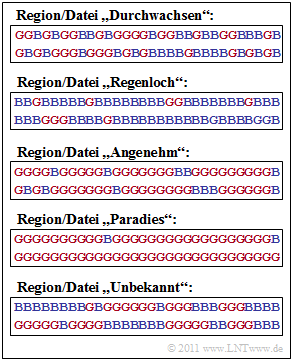Exercise 1.1: Entropy of the Weather
A weather station queries different regions every day and receives a message $x$ back as a response in each case, namely
- $x = \rm B$: The weather is rather bad.
- $x = \rm G$: The weather is rather good.
The data were stored in files over many years for different regions, so that the entropies of the $\rm B/G$–sequences can be determined:
- $$H = p_{\rm B} \cdot {\rm log}_2\hspace{0.1cm}\frac{1}{p_{\rm B}} + p_{\rm G} \cdot {\rm log}_2\hspace{0.1cm}\frac{1}{p_{\rm G}}$$
with the binary logarithm
- $${\rm log}_2\hspace{0.1cm}p=\frac{{\rm lg}\hspace{0.1cm}p}{{\rm lg}\hspace{0.1cm}2}\hspace{0.3cm} \left ( = {\rm ld}\hspace{0.1cm}p \right ) \hspace{0.05cm}.$$
Here, „lg” denotes the logarithm to the base $10$. It should also be mentioned that the pseudo-unit $\text{bit/query}$ must be added in each case.
The graph shows these binary sequences for $60$ days and the following regions:
- Region „mixed”: $p_{\rm B} = p_{\rm G} =0.5$,
- Region „rainy”: $p_{\rm B} = 0.8, \; p_{\rm G} =0.2$,
- Region „pleasant”: $p_{\rm B} = 0.2, \; p_{\rm G} =0.8$,
- Region „paradise”: $p_{\rm B} = 1/30, \; p_{\rm G} =29/30$.
Finally, the file „Unknown” is also given, whose statistical properties are to be estimated.
Hinss:
- This task belongs to the chapter Discrete Memoryless Sources.
- For the first four files it is assumed that the events $\rm B$ and $\rm G$ are statistically independent, a rather unrealistic assumption for weather practice.
- he task was designed at a time when Greta was just starting school. We leave it to you to rename „paradise” to „hell”.
Questions
Solution
- $$H_{\rm D} = 0.5 \cdot {\rm log}_2\hspace{0.1cm}\frac{1}{0.5} + 0.5 \cdot {\rm log}_2\hspace{0.1cm}\frac{1}{0.5} \hspace{0.15cm}\underline {= 1\,{\rm bit/Anfrage}}\hspace{0.05cm}.$$
(2) Mit $p_{\rm B} = 0.8$ und $p_{\rm G} =0.2$ erhält man einen kleineren Entropiewert:
- $$H_{\rm R} \hspace{-0.05cm}= \hspace{-0.05cm}0.8 \cdot {\rm log}_2\hspace{0.05cm}\frac{5}{4} \hspace{-0.05cm}+ \hspace{-0.05cm}0.2 \cdot {\rm log}_2\hspace{0.05cm}\frac{5}{1}\hspace{-0.05cm}=\hspace{-0.05cm} 0.8 \cdot{\rm log}_2\hspace{0.05cm}5\hspace{-0.05cm} - \hspace{-0.05cm}0.8 \cdot {\rm log}_2\hspace{0.05cm}4 \hspace{-0.05cm}+ \hspace{-0.05cm}0.2 \cdot {\rm log}_2 \hspace{0.05cm} 5 \hspace{-0.05cm}=\hspace{-0.05cm} {\rm log}_2\hspace{0.05cm}5\hspace{-0.05cm} -\hspace{-0.05cm} 0.8 \cdot {\rm log}_2\hspace{0.1cm}4\hspace{-0.05cm} = \hspace{-0.05cm} \frac{{\rm lg} \hspace{0.1cm}5}{{\rm lg}\hspace{0.1cm}2} \hspace{-0.05cm}-\hspace{-0.05cm} 1.6 \hspace{0.15cm} \underline {= 0.722\,{\rm bit/Anfrage}}\hspace{0.05cm}.$$
(3) In der Datei „Angenehm” sind die Wahrscheinlichkeiten gegenüber der Datei „Regenloch” genau vertauscht. Durch diese Vertauschung wird die Entropie jedoch nicht verändert:
- $$H_{\rm A} = H_{\rm R} \hspace{0.15cm} \underline {= 0.722\,{\rm bit/Anfrage}}\hspace{0.05cm}.$$
(4) Mit $p_{\rm B} = 1/30$ und $p_{\rm G} =29/30$ ergeben sich folgende Informationsgehalte:
- $$I_{\rm B} \hspace{0.1cm} = \hspace{0.1cm} {\rm log}_2\hspace{0.1cm}30 = \frac{{\rm lg}\hspace{0.1cm}30}{{\rm lg}\hspace{0.1cm}2} = \frac{1.477}{0.301} \hspace{0.15cm} \underline {= 4.907\,{\rm bit/Anfrage}}\hspace{0.05cm},$$
- $$I_{\rm G} \hspace{0.1cm} = \hspace{0.1cm} {\rm log}_2\hspace{0.1cm}\frac{30}{29} = \frac{{\rm lg}\hspace{0.1cm}1.034}{{\rm lg}\hspace{0.1cm}2} = \frac{1.477}{0.301} \hspace{0.15cm} \underline {= 0.049\,{\rm bit/Anfrage}}\hspace{0.05cm}.$$
(5) Die Entropie $H_{\rm P}$ ist der mittlere Informationsgehalt der beiden Ereignisse $\rm B$ und $\rm G$:
- $$H_{\rm P} = \frac{1}{30} \cdot 4.907 + \frac{29}{30} \cdot 0.049 = 0.164 + 0.047 \hspace{0.15cm} \underline {= 0.211\,{\rm bit/Anfrage}}\hspace{0.05cm}.$$
- Obwohl (genauer: weil) das Ereignis $\rm B$ seltener auftritt als $\rm G$, ist sein Beitrag zur Entropie größer.
(6) Richtig sind die Aussagen 1 und 3:
- $\rm B$ und $\rm G$ sind bei der Datei „Unbekannt” tatsächlich gleichwahrscheinlich: Die $60$ dargestellten Symbole teilen sich auf in $30$ mal $\rm B$ und $30$ mal $\rm G$.
- Es bestehen nun aber starke statistische Bindungen innerhalb der zeitlichen Folge. Nach längeren Schönwetterperioden folgen meist viele schlechte Tage am Stück.
- Aufgrund dieser statistischen Abhängigkeit innerhalb der $\rm B/G$–Folge ist $H_\text{U} = 0.722 \; \rm bit/Anfrage$ kleiner als $H_\text{D} = 1 \; \rm bit/Anfrage$.
- $H_\text{D}$ ist gleichzeitig das Maximum für $M = 2$ ⇒ die letzte Aussage ist mit Sicherheit falsch.
